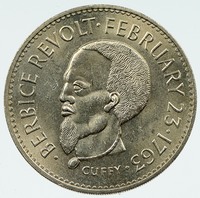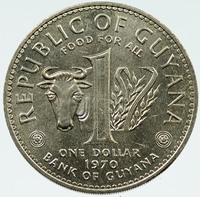Guyana - FAO - Food for all / Proclamation of Republic Commemorative issue
1970 Copper-nickel 1 Dollar 35.5mm (19.20 grams)
Reference: KM# 36, Schön# 36
BERBICE REVOLT FEBRUARY 23 1763 CUFFY, Head Cuffy left.
REPUBLIC OF GUYANA FOOD FOR ALL 1 ONE DOLLAR
1970 BANK OF GUYANA, Bulls head left of denomination, paddy stalks right of denomination. You are bidding on the exact item pictured, provided with a Certificate of Authenticity and Lifetime Guarantee of Authenticity.
Cuffy, also spelled as Kofi or Koffi (died in 1763), was an Akan man who was captured in his native West Africa and stolen for slavery to work on the plantations of the Dutch colony of Berbice in present-day Guyana. In 1763, he led a major slave revolt of more than 3,800 slaves against the colonial regime. Today, he is a national hero in Guyana.[1] The Berbice slave uprisingCoffy lived in Lilienburg, a plantation on the Berbice River, as a house-slave for a cooper (barrel maker). He was owned by the widow Berkey. On 23 February 1763, slaves on plantation Magdalenenberg on the Canje River rebelled, protesting harsh and inhumane treatment. They torched the plantation house, and made for the Courantyne River where Caribs and troops commanded by Governor Wigbold Crommelin [nl] of Suriname attacked, and killed them. On 27 February 1763, a revolt took place on the Hollandia plantation next to Lilienburg. Coffy is said to have organized the slaves into a military unit, after which the revolt spread to neighbouring plantations.[5] When Dutch Governor Wolfert Simon Van Hoogenheim sent military assistance to the region, the rebellion had reached the Berbice River and was moving steadily towards the Berbice capital, Fort Nassau. They took gunpowder and guns from the attacked plantations. By 3 March, the rebels were 600 in number. Led by Cossala, they tried to take the brick house of Peerenboom. They agreed to allow the whites to leave the brick house, but as soon they left, the rebels killed many and took several prisoners, among them Sara George, the 19-year-old daughter of the Peerenboom Plantation owner,[8] whom Coffy kept as his wife. Coffy was soon accepted by the rebels as their leader and declared himself Governor of Berbice. Doing so he named Captain Accara as his deputy in charge of military affairs, and tried to establish discipline over the troops. Accara was skilful in military discipline. They organized the farms in order to provide food supplies. Defeat of the rebellionWolfert Simon van Hoogenheim committed himself to retake the colony. Accara attacked the whites three times without permission from Coffy, and eventually the colonists were driven back. Thus began a dispute among the two rebels. On 2 April 1763, Coffy wrote to Van Hoogenheim saying that he did not want a war against the whites and proposed a partition of Berbice with the whites occupying the coastal areas and the blacks the interior. Van Hoogenheim delayed his decision replying that the Society of Berbice in Amsterdam had to make that decision and that it would take three to four months. He was waiting for support from neighboring colonies; a ship from Suriname had already arrived, and reinforcements from Barbados and Sint Eustatius soon followed. Coffy then ordered his forces to attack the whites in May 1763, but in so doing had many losses. The defeat opened a division among the rebels and weakened their organization. Accara became the leader of a new faction opposed to Coffy and led to a civil war among themselves. On 19 October 1763, it was reported to the governor that Captains Atta had revolted against Coffy, and that Coffy had committed suicide. In the meantime, the colonists had already been strengthened by the arrival of soldiers. On 15 April 1764 Captain Accabre, the last of the insurgents, was captured. National heroThe anniversary of the Coffy slave rebellion, 23 February, has been Republic Day in Guyana since 1970. Coffy is commemorated in the 1763 Monument in the Square of the Revolution in the capital Georgetown. This statue is called the 1763 Monument or the Cuffy Monument. The statue was designed by the Guyanese sculptor Philip Moore. It stands at 15 feet tall and weighs two and a half tons. The figure of Cuffy standing on top has many symbols. His pouting mouth symbolizes his defiance, the face on his chest forms a symbolic breastplate that gives protection during battle, and the honed faces on his thighs represent revolutionaries from Guyanese history. He holds in his hands a dog and a pig, both being throttled with the dog representing covetousness and greed while the pig represents ignorance.
The Food and Agriculture Organization of the United Nations (FAO) ] is a specialized agency of the United Nations that leads international efforts to defeat hunger and improve nutrition and food security. Its Latin motto, fiat panis, translates to "let there be bread". It was founded in October 1945. The FAO is composed of 197 member states. It is headquartered in Rome, Italy, and maintains regional and field offices around the world, operating in over 130 countries. It helps governments and development agencies coordinate their activities to improve and develop agriculture, forestry, fisheries, and land and water resources. It also conducts research, provides technical assistance to projects, operates educational and training programs, and collects data on agricultural output, production, and development. The FAO is governed by a biennial conference representing each member country and the European Union, which elects a 49-member executive council. The Director-General, currently Qu Dongyu of China, serves as the chief administrative officer. There are various committees governing matters such as finance, programs, agriculture, and fisheries.
  Guyana (pronounced /ɡaɪˈɑːnə/ or /ɡaɪˈænə/), officially the Co‑operative Republic of Guyana, is a country on the northern mainland of South America. It is considered part of the Caribbean region because of its strong cultural, historical, and political ties with other Caribbean countries and the Caribbean Community (CARICOM). Guyana is bordered by the Atlantic Ocean to the north, Brazil to the south and southwest, Venezuela to the west, and Suriname to the east. With 215,000 square kilometres (83,000 sq mi), Guyana is the third-smallest sovereign state on mainland South America after Uruguay and Suriname. Guyana (pronounced /ɡaɪˈɑːnə/ or /ɡaɪˈænə/), officially the Co‑operative Republic of Guyana, is a country on the northern mainland of South America. It is considered part of the Caribbean region because of its strong cultural, historical, and political ties with other Caribbean countries and the Caribbean Community (CARICOM). Guyana is bordered by the Atlantic Ocean to the north, Brazil to the south and southwest, Venezuela to the west, and Suriname to the east. With 215,000 square kilometres (83,000 sq mi), Guyana is the third-smallest sovereign state on mainland South America after Uruguay and Suriname.
The region known as "the Guianas" consists of the large shield landmass north of the Amazon River and east of the Orinoco River known as the "land of many waters". There are nine indigenous tribes residing in Guyana: the Wai Wai, Macushi, Patamona, Lokono, Kalina, Wapishana, Pemon, Akawaio and Warao. Historically dominated by the Lokono and Kalina tribes, Guyana was colonised by the Dutch before coming under British control  in the late 18th century. It was governed as British Guiana, with a mostly plantation-style economy until the 1950s. It gained independence in 1966, and officially became a republic within the Commonwealth of Nations in 1970. The legacy of British rule is reflected in the country's political administration and diverse population, which includes Indian, African, Amerindian, Chinese, Portuguese, other European, and various multiracial groups. In 2017, 41% of the population of Guyana lived below the poverty line. in the late 18th century. It was governed as British Guiana, with a mostly plantation-style economy until the 1950s. It gained independence in 1966, and officially became a republic within the Commonwealth of Nations in 1970. The legacy of British rule is reflected in the country's political administration and diverse population, which includes Indian, African, Amerindian, Chinese, Portuguese, other European, and various multiracial groups. In 2017, 41% of the population of Guyana lived below the poverty line. Guyana is the only South American nation in which English is the official language. The majority of the population, however, speak Guyanese Creole, an English-based creole language, as a first language. Guyana is part of the Anglophone Caribbean. CARICOM is headquartered in Guyana's capital and largest city, Georgetown. In 2008, the country joined the Union of South American Nations as a founding member.
|



 Guyana (pronounced /ɡaɪˈɑːnə/ or /ɡaɪˈænə/), officially the Co‑operative Republic of Guyana, is a country on the northern mainland of South America. It is considered part of the Caribbean region because of its strong cultural, historical, and political ties with other Caribbean countries and the Caribbean Community (CARICOM). Guyana is bordered by the Atlantic Ocean to the north, Brazil to the south and southwest, Venezuela to the west, and Suriname to the east. With 215,000 square kilometres (83,000 sq mi), Guyana is the third-smallest sovereign state on mainland South America after Uruguay and Suriname.
Guyana (pronounced /ɡaɪˈɑːnə/ or /ɡaɪˈænə/), officially the Co‑operative Republic of Guyana, is a country on the northern mainland of South America. It is considered part of the Caribbean region because of its strong cultural, historical, and political ties with other Caribbean countries and the Caribbean Community (CARICOM). Guyana is bordered by the Atlantic Ocean to the north, Brazil to the south and southwest, Venezuela to the west, and Suriname to the east. With 215,000 square kilometres (83,000 sq mi), Guyana is the third-smallest sovereign state on mainland South America after Uruguay and Suriname.  in the late 18th century. It was governed as British Guiana, with a mostly plantation-style economy until the 1950s. It gained independence in 1966, and officially became a republic within the Commonwealth of Nations in 1970. The legacy of British rule is reflected in the country's political administration and diverse population, which includes Indian, African, Amerindian, Chinese, Portuguese, other European, and various multiracial groups. In 2017, 41% of the population of Guyana lived below the poverty line.
in the late 18th century. It was governed as British Guiana, with a mostly plantation-style economy until the 1950s. It gained independence in 1966, and officially became a republic within the Commonwealth of Nations in 1970. The legacy of British rule is reflected in the country's political administration and diverse population, which includes Indian, African, Amerindian, Chinese, Portuguese, other European, and various multiracial groups. In 2017, 41% of the population of Guyana lived below the poverty line. 
